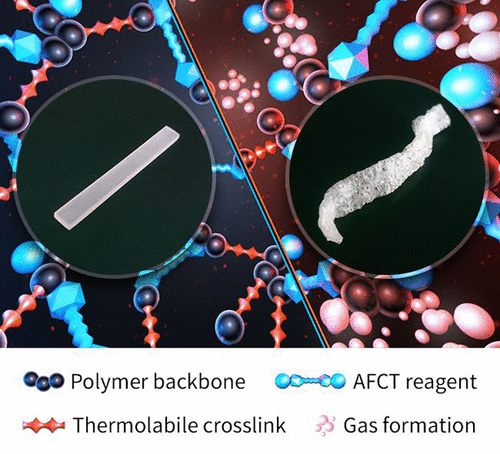当前位置:
X-MOL 学术
›
Macromolecules
›
论文详情
Our official English website, www.x-mol.net, welcomes your
feedback! (Note: you will need to create a separate account there.)
Debonding on Demand with Highly Cross-Linked Photopolymers: A Combination of Network Regulation and Thermally Induced Gas Formation
Macromolecules ( IF 5.1 ) Pub Date : 2018-01-16 00:00:00 , DOI: 10.1021/acs.macromol.7b02321 Christian Gorsche 1, 2 , Christoph Schnoell 1, 2 , Thomas Koch 3 , Norbert Moszner 2, 4 , Robert Liska 1, 2
Macromolecules ( IF 5.1 ) Pub Date : 2018-01-16 00:00:00 , DOI: 10.1021/acs.macromol.7b02321 Christian Gorsche 1, 2 , Christoph Schnoell 1, 2 , Thomas Koch 3 , Norbert Moszner 2, 4 , Robert Liska 1, 2
Affiliation

|
Photopolymerizable glues and cements that offer debonding on demand (DoD) through an external stimulus are of great interest for the fields of recycling and repair. State-of-the-art DoD solutions often require a high-energy impulse (e.g., >200 °C, strong force), which is due to the typical glassy nature of such photopolymer networks. Herein, various blocked isocyanates (BICs) that enable thermally induced gas formation at temperatures far below 200 °C are studied. Thermally induced gas bubble formation is accomplished within a linear, thermoplastic poly(N-acryloylmorpholine) matrix above glass transition temperature, introducing porosity. The resulting porosity within the material then causes mechanical failure. However, highly cross-linked photopolymer networks remain unchanged due to their glassy nature at temperatures well above 150 °C. A BIC-based thermolabile photopolymerizable cross-linker is prepared in order to create a polymer network with cleavable cross-link. Additionally, a β-allyl sulfone-based chain transfer reagent is used to tune the final cross-linking density and thermomechanical properties of the material. Above the resulting sharp glass transition (>60 °C), plastic deformation becomes possible, thus allowing formation of porosity. This introduces a covalently cross-linked, thermolabile photopolymer with a tailored network architecture as potential glue for DoD at ∼150 °C.
中文翻译:

高度交联的光敏聚合物按需脱胶:网络调节和热诱导气体形成的结合
通过外部刺激提供按需脱胶(DoD)的可光聚合胶水和胶粘剂对于回收和维修领域非常重要。先进的DoD解决方案通常需要高能量脉冲(例如,> 200°C,强力),这是由于此类光聚合物网络的典型玻璃状性质所致。在本文中,研究了各种封端异氰酸酯(BIC),它们能够在远低于200°C的温度下形成热诱导气体。热诱导气泡的形成是在线性热塑性聚(N-丙烯酰吗啉)基体在玻璃化转变温度以上,会引入孔隙。然后,材料内产生的孔隙会导致机械故障。然而,由于高度交联的光敏聚合物网络在远高于150°C的温度下呈玻璃状,因此保持不变。制备基于BIC的热不稳定的可光聚合的交联剂,以产生具有可裂解的交联的聚合物网络。另外,使用基于β-烯丙基砜的链转移剂来调节材料的最终交联密度和热机械性能。在所产生的急剧的玻璃化转变温度(> 60°C)以上,可能发生塑性变形,从而形成孔隙。这引入了具有定制网络结构的共价交联的不耐热光敏聚合物,作为约150°C下DoD的潜在胶。
更新日期:2018-01-16
中文翻译:

高度交联的光敏聚合物按需脱胶:网络调节和热诱导气体形成的结合
通过外部刺激提供按需脱胶(DoD)的可光聚合胶水和胶粘剂对于回收和维修领域非常重要。先进的DoD解决方案通常需要高能量脉冲(例如,> 200°C,强力),这是由于此类光聚合物网络的典型玻璃状性质所致。在本文中,研究了各种封端异氰酸酯(BIC),它们能够在远低于200°C的温度下形成热诱导气体。热诱导气泡的形成是在线性热塑性聚(N-丙烯酰吗啉)基体在玻璃化转变温度以上,会引入孔隙。然后,材料内产生的孔隙会导致机械故障。然而,由于高度交联的光敏聚合物网络在远高于150°C的温度下呈玻璃状,因此保持不变。制备基于BIC的热不稳定的可光聚合的交联剂,以产生具有可裂解的交联的聚合物网络。另外,使用基于β-烯丙基砜的链转移剂来调节材料的最终交联密度和热机械性能。在所产生的急剧的玻璃化转变温度(> 60°C)以上,可能发生塑性变形,从而形成孔隙。这引入了具有定制网络结构的共价交联的不耐热光敏聚合物,作为约150°C下DoD的潜在胶。











































 京公网安备 11010802027423号
京公网安备 11010802027423号